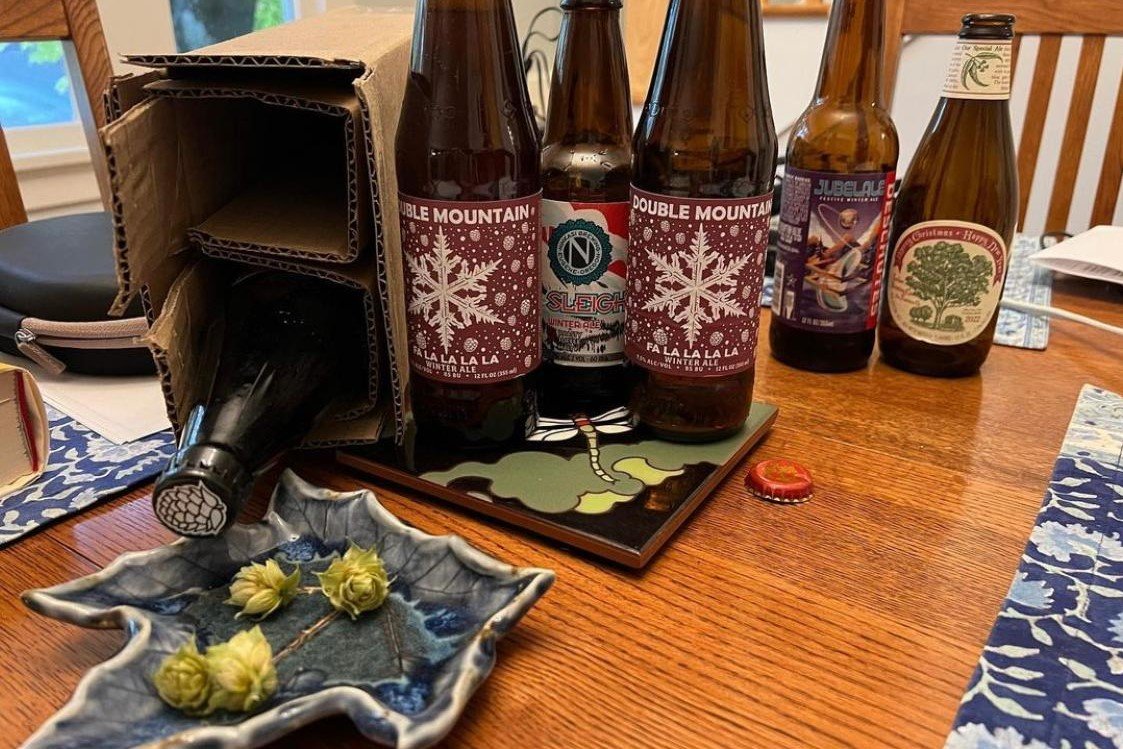Holidays and Their Ales
As Patrick and I were recording Podcast 172 and drinking Double Mountain’s Fa La La La La, the UPS man interrupted with … a shipment of Fa La La La La. Serendipity.
Tomorrow Americans celebrate Thanksgiving, our one completely North American holiday. It commemorates an invented event, and the circumstances surrounding the European encounter with native Americans was hardly amicable. But in motivation, the idea has merit: we reserve the fourth Thursday of November for a time of friendliness and thanksgiving. Thanksgiving is also marks the unofficial start to winter, with all the fixtures of the season that entails.
Back in the early days of the craft brewing era, breweries sometimes made a beer they described as a “winter warmer.” It’s not a style exactly, though it became one here in the Northwest. Elsewhere, interpretations were a bit broader, and often included spicing. Although the name suggests a British origin, spicing is more typical of bières de Noël, which are a nearly ubiquitous in Belgium. (See Beervana Show 95 for a full style exploration of those.) The classic in this genre is Anchor’s Our Special Ale, though Highland’s Cold Mountain may have more currency on the East Coast.
In our most recent podcast, Patrick and I survey American winter ales and discuss how they’ve lost cohesion in recent years as a category of darkish stong ales. Once, these beers were king around here. It was a surprisingly uniform style: a 7% dark ale (copper to brown, but generally chestnut), full and malty but with a layer of classic hopping (in the Willamette/Mt Hood vein). The latitude in the style was narrow: sweetly malty to a slightly roasty malt on the one hand, mild to somewhat stiff hopping on the other. Many breweries made them, but the classics were Deschutes Jubelale, Full Sail Wassail, and Pyramid Snow Cap.
Perhaps twenty years is long enough for any seasonal to thrive, so I shouldn’t lament that things started changing in the late aughts. Breweries first branched out into other kinds of dark ales, but inevitably, IPAs started sneaking into the picture. One of the first I recall is Hopworks’ Abominable Ale, a malty C-hop IPA that featured a freight train of bitterness. It was “wintry” in that the C-hops created a piney quality. But mostly it was just a burly IPA.
The style achieved something close to a platonic ideal when Double Mountain released Fa La La La La, a beer that ramped up the pine to ten. Patrick and had a bottle on hand for the podcast, and sure enough, it still delivered the goods. Interestingly, we’ve come far enough that the old-school pine is coming back around, along with traditional IPAs. Fa La La La La isn’t quite modern in that it has a rich, full malt base supporting the hops, but that makes it more appropriate for the winter months. I don’t expect we’ll see a return to the Jubel-style winter warmers anytime soon, but I wouldn’t be surprised to see piney IPAs return as seasonal standards. Reuben’s for example, has returned their Stay Frosty, a cold IPA full of C-hops, for winter. That seems pretty on-brand for the winter months.
Since Twitter is dying, perhaps we can get back to commenting on blogs. I invite you to discuss your favorite winter beers and what you plan on serving with your roast beast tomorrow. Cheers and happy Thanksgiving—

